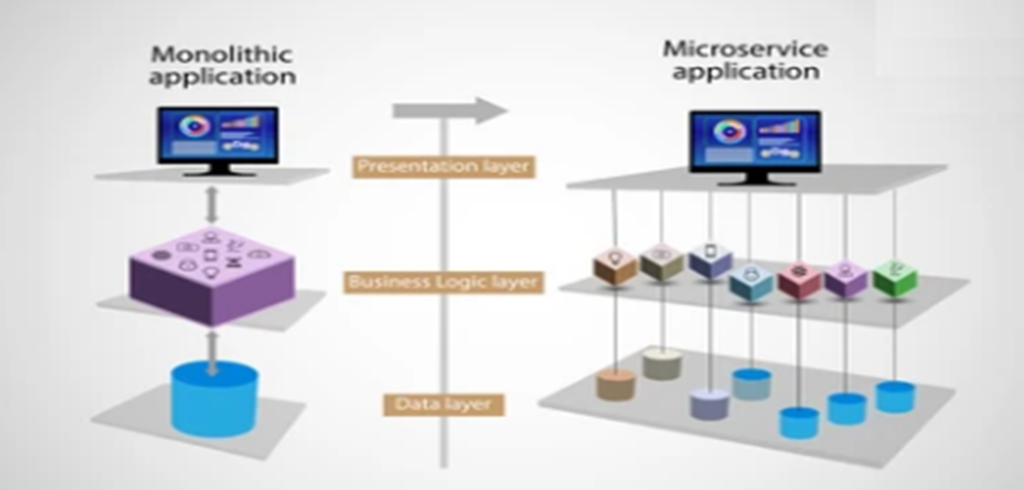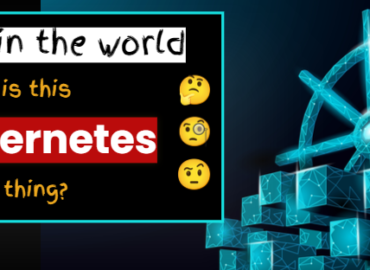Introduction
This blog will cover:
- What is Microservices architecture?
- What is Monolithic architecture? and what are limitations and problems associated with it?
- Commonalities and Differences among both the architectures.
What is microservices Architecture?
- It’s a Next-generation application architectural approach of application modernization. Microservices are created for collaborating services. Each of them is a small-scale service that performs functions from a single business area. The division of large projects into small ones has gained more importance, especially among developers, and the impact of microservices on Ecommerce is momentous.
- Microservice architecture divides services into small, autonomous elements, each with its independent functions such as containers.
Following are the best containerization tools, available in the market:
- Docker Engine
- Podman
- ContainerD
There are following cloud-based managed containerization Tools that are available in the market. Which we can use to manage containers and to avoid complex setups and administrative overhead:
- AWS-ECS(Elastic Container service).
- ACS(Azure Container service).
- GCS(Google Container service).
Following cloud-based managed orchestration management tools can help avoid complex cluster setups and administrative overhead:
- Google Kubernetes Engine(GKE).
- AWS Elastic Kubernetes service(AWS_EKS).
- Azure Kubernetes service(AKE).
- IBM Cloud Kubernetes service.
All above orchestration management tools provide following features:
- Networking.
- Highly availability.
- Scalability.
- Load balancing on service level.
- Security & Compliance.
- Administrative overhead.
Examples
Following well-known companies utilize microservices architecture for their services:
- PayPal
- Amazon
- Youtube
- The Guardian
Benefits
- Highly maintainable and testable: Supports agile development and rapid deployment of services.
- Loosely coupled: Application is broken into modular, loosely coupled components, when changes done in the one service, will not disturb to another services.
- Autonomous services:
- Application can be distributed across clouds and data centers. Each service internally controls its own logic with the help of separate API.
- Each service connect with API-Gateway via API, One service communicate to another service through API-Gateway.
- Each service keep separate database and storage.
- Independently deployable: Code can be written in different languages and can be updated in one service without affecting the full application.
- Focused on Scalability, Highly available: Make scalable and highly available to application services such as [Chatting service, logging service, News feed service] with the help of following best orchestration(Container) management tool that are available in the market.
- Kubernetes
- Docker Swarm
- Openshift
What is Monolithic Approach?
Monolithic architecture is a traditional architectural approach of structure software in a single tier. Like a stone pillar, the resulting product is large with monolithic architectures, and components all coexist in a single deployment. One large team generally maintains the source code in a centralized repository visible to all engineers, who commit their code in a single build. These teams typically use standardized tools and follow a sequential process to build, review, test, deliver, and deploy code.

Common Issues with Monolithic Approach:
- Tiredly coupled components, Application is not broken into modular.
- Every element is closely related and dependent on the others, so it is difficult.
- Updating can be a challenge as it redeployment of the application.
- The IDE can become overloaded, and size may also slow down startup time.
- A large code base can be significantly harder to understand
Monolithic vs Microservices

I’ve broken down the verdict into the different areas that you might consider and assessed each one in both scenarios.
| Area | Monolithic architecture | Microservices architecture |
| Deployment | Deployment is simple. But if something goes wrong, the whole project will break down and it will be hard to fix it. | Deployment is complex. Each microservice must be implemented separately, which extends the implementation process. If something goes wrong, only one service will be damaged, and it will be easier to fix it. |
| Maintenance | Maintenance is slow. If programmer goes to test element so it Waste programmer’s time and decreases efficiency. | Maintenance is fast, If programmer goes to test element so it save programmer’s time and increases efficiency. |
| Reliability | It’s unstable. If something goes wrong in monolithic architecture, it can stop the whole structure. Meanwhile. | It’s stable. If something goes wrong in microservices architecture, it can’t stop the whole structure. |
| Scalability | Scalability is difficult to achieve due to the size and scale of the structure. This option is hard to upgrade. | Scalability is much easier because we can scale only those parts that require more resources. |
| Development | The Team has to work in parallel on the same code because each application can’t be delivered independently. | The Team doesn’t have to work in parallel on the same code because each application can be delivered independently. |
| Releases | Slow releases of new features. | Faster releases of new features. |
| Cost | Affordable and faster to develop, However each case must be considered individually. For businesses, monoliths involve one huge investment. | Expensive, and the whole development takes more time than in monolith. However in the long run, they can cost less, if we count developer’s work time in the long-run will be less |
Conclusion
The main idea behind microservices is that some types of applications are easier to build and maintain when they are broken down into many small pieces that work together. Though the architecture has increased complexity, Cause, Enterprises are moving towards application modernization by the business. Business demands greater and greater agility, performance scalability, and responsiveness.
It is advisable to carefully design the application architecture and its suitability for microservices architecture as well as the complexity of underlying infrastructure/solutions, in order to get the best value with optimum cost efficiency.




Great informative blog